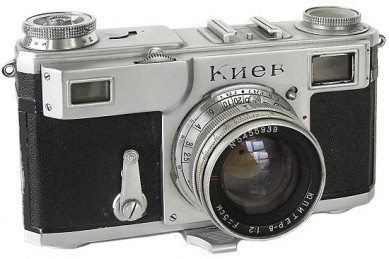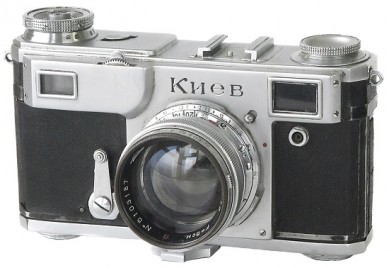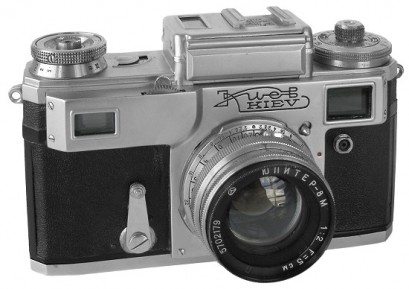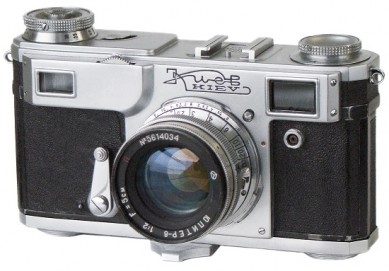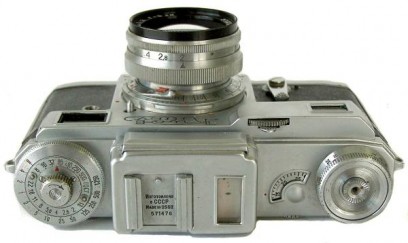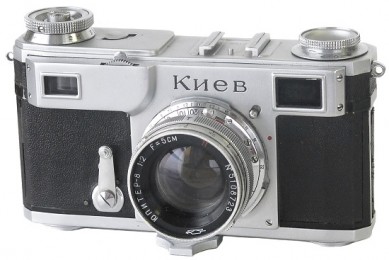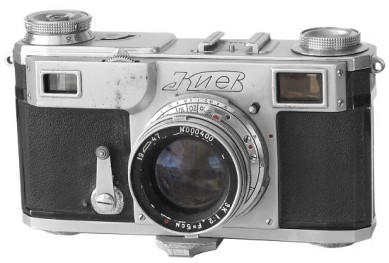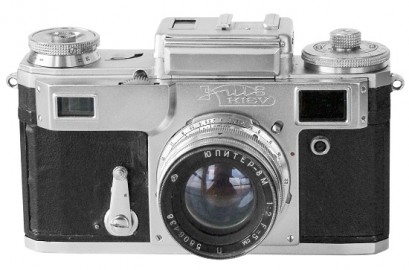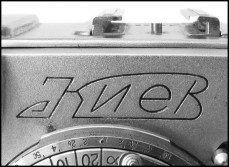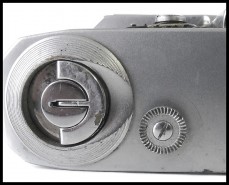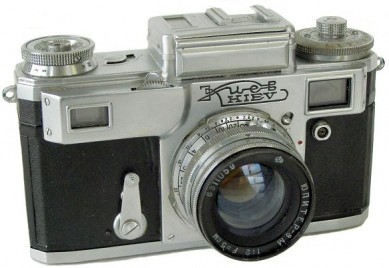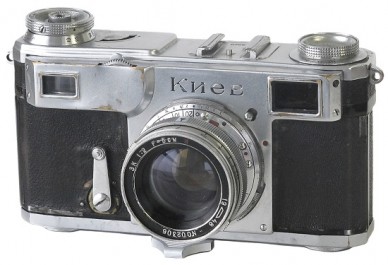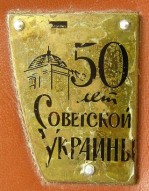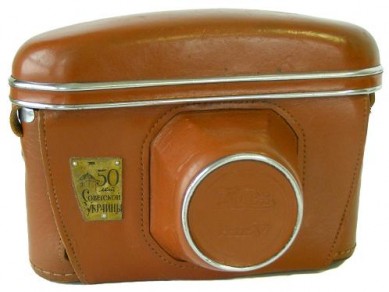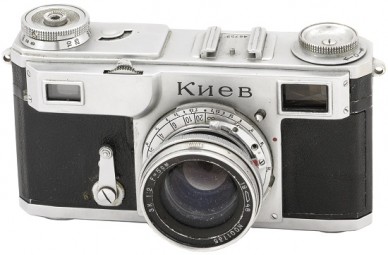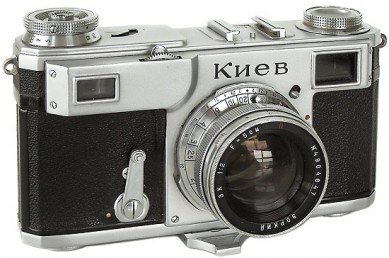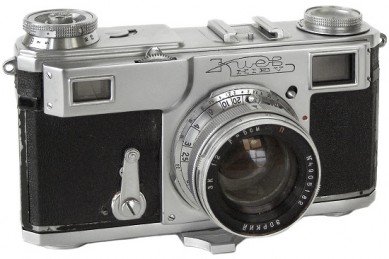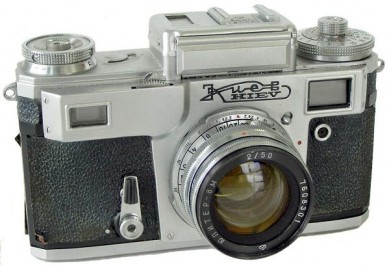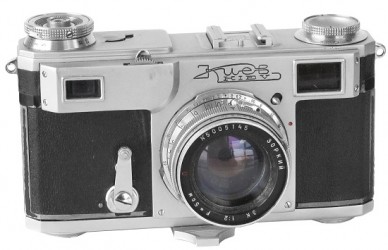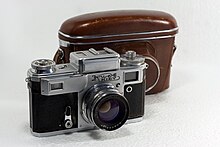|
|||||||||||||||||||||||||||||||||||||||||||||||||||||||||||||||||||||||||||||||||||
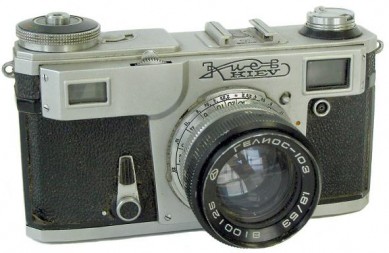 |
|||||||||||||||||||||||||||||||||||||||||||||||||||||||||||||||||||||||||||||||||||
|

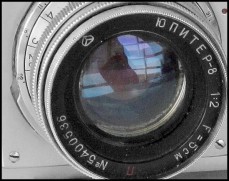
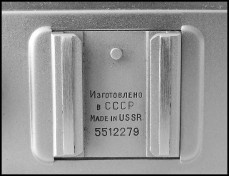
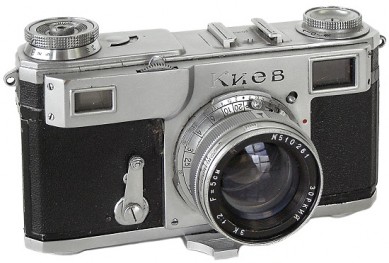
Kiev (brand)
Jump to navigation Jump to search
Kiev is a Soviet and Ukrainian brand of photographic equipment including cameras manufactured by the Arsenal Factory in Kiev, Ukraine. The camera nameplates show the name “KIEV”, with older cameras using “КИЕВ” (in Russian language) or “КИЇВ” (in Ukrainian language)[1] in Cyrillic.
At the end of November 2009 Gevorg Vartanyan of Arax, a Ukrainian distributor of reworked medium format Kiev cameras and lenses, wrote to tell customers that the Arsenal factory was closing after 245 years of operation. The email said that management had been turned over to the Special Construction Department (SKTB), all work had stopped and the workers laid off, and that the factory warehouse was empty. He thought that Arax had enough cameras and parts to remain in business for at least another 4–5 years.[2] The amount of stock remaining with other distributors around the world is unknown.
Kiev medium format cameras
The Kiev brand is probably best known for two 6×6 medium format cameras:
Kiev 88
An almost direct clone of the original Hasselblad 1600 F sometimes jokingly referred to as a Hasselbladski.
Originally called “Salyut”, it added a self-timer mechanism below the film advance knob to the original Hasselblad design. However, this add-on was abandoned and is seen only on very early or prototype cameras. The Salyut went into mass production around 1957. An automatic aperture mechanism was later added and the camera’s designation was changed to “Salyut C”. After “Salyut C” the camera model evolved into “Kiev 80”. With the further addition of a hot shoe for electronic flashes, the camera’s name became “Kiev 88”. It was sometimes exported to the West as the “Zenith 80″.
The Kiev 88 used a screw type lens mount similar to the original Hasselblad mount, however there are mixed reports on compatibility between the two. Most film backs are not compatible between Kievs and Hasselblads due to different gear mechanisms. However, Kiev 88 viewfinders are compatible with the Hasselblad 1600F and 1000F, and even current Hasselblad V-system models.
The Kiev 88 lens mount was modified to accept most Pentacon Six mount lenses around 1999 and designated the Kiev 88CM. Many of these cameras have found their way around the world, especially to the United States. They are considered inexpensive alternatives in the medium film format camera market (see below).
Kiev 60
The Kiev 60 is similar to an enlarged 35 mm SLR, based loosely on the Pentacon Six and using the same breech-lock lens mount. This camera was originally called the Kiev 6C with a shutter release button activated by the left hand, and accepting both 220 and 120 film. The current Kiev 60 has a more conventional right-handed shutter release, but does not take 220 film. The Kiev 60 has a simpler frame-advancement mechanism than the Pentacon Six but it is often poorly adjusted at the factory resulting in incorrect frame spacing.[3] This problem can be fixed.[4]
There is both a waist level finder and metered prism finder available. It has no removable film back, thus making the Kiev 60 design simpler and less prone to light leaks, which is sometimes a problem with the Kiev 88 design.
Attractions of Kiev cameras, and problems
The low price of the Kiev medium format cameras has attracted many amateur photographers wishing to enter the medium format camera market on a budget. Some have reported that the prices of a Kiev camera setup with other Russian or Ukrainian components (e.g. lenses) can be 1/10 to 1/15 the price of a similar Hasselblad setup. This being true for comparison with other similar cameras in the 1990s and still for today regarding specifically Hasselblad, the prices of 6×4.5, 6×6 and 6×7 SLR cameras and lenses from more reliable producers like Mamiya, Bronica and Pentax came down to prices comparable or even cheaper as for Kievs beginning by the mid 2000s.
Historically, the Arsenal plant is reported to have generally poor quality control and some buyers have reported receiving cameras with small cosmetic or functional defects. Many of the less favorable reviews come from people comparing the camera directly to the more expensive Hasselblad models. The quality control seems to have fluctuated throughout different years of production though, and thus varies from camera to camera.
For this reason a number of third party distributors have appeared offering Kiev cameras in safer, quality controlled forms. However some have taken advantage of the Arsenal plant’s variable quality to add value through varying levels of third-party rebuilding, modification, and testing of the Arsenal-supplied cameras.
The cameras however, still have a number of quirks that no simple servicing will remove. The most notable quirk is that the shutter speed on some of the original Kiev 88 cameras should only be changed after cocking the shutter (spring-loading the shutter mechanism and advancing the film). Changing the shutter speed on an un-cocked camera will damage the timing mechanism.[5] This is not a problem with the Kiev 60 and Kiev 88CM variants. There are also mixed reports that the shutter speed dial should be turned only clock-wise, never anti-clock-wise. This is certainly known to be an issue with cameras modified by Hartblei to add a mirror lock-up (MLU) feature. Other cameras may or may not have this problem.
Common modifications
The vendors that sell Kiev cameras outside of the former Soviet Union often make their own modifications to the cheap and basic cameras coming from the factory.
Mirror lock-up is a feature that can be added to the Salyut-C, Kiev-88 and Kiev-60. This removes the small amount of motion blur that can be caused by the mirror hitting the top of the mirror box just before the shutter opens. (Other sources of motion-blur still remain however). It is most useful when the subject is greatly magnified e.g. using a long or telephoto lens, or doing macro photography.
The Kiev 60 is sometimes modified to shoot with a 6×4.5 frame size, often called “Kiev 645” or similar, yielding more pictures per roll of film in a “print-friendly” rectangular format versus the original camera’s square 6×6 format. But since the film feeds sideways, the 6×4.5 variant produces photos in the portrait aspect, as opposed to the landscape aspect seen in most other cameras. The Kiev 88 can shoot the 6×4.5 frame size by simply using a different film back. The 6×4.5 film back is interchangeable with others for 6×6 and other frame sizes, while the Kiev 60 modification is permanent.
Lenses
One of the reasons for the lasting demand for these cameras is the price of the lenses that can be used on them. Despite the cheap price, the Kiev lenses are high quality optic wise, with many of the lenses being based on Zeiss designs. Among the best is the Arsat MC 1:3.5/30 mm fisheye lens, previously known as the “Zodiak 8” in a single-coated version. This lens is reputedly quite good and generally available for under US$250, which is stunning since one would have to spend many thousands of dollars to get a non-Ukrainian equivalent lens of this type.[6]
Medium format lenses produced by Arsenal for Kiev cameras:
- 1:3.5/30 mm Arsat fisheye lens (formerly called Zodiak 8)
- 1:3.5/45 mm Arsat (formerly called Mir-26)
- 1:4.5/55 mm Arsat shift lens
- 1:3.5/65 mm Mir-38
- 1:3.5/65 mm Mir-3 (discontinued – was much larger than the later Mir-38)
- 1:2.8/80 mm Arsat (formerly called Volna)
- 1:2.8/90 mm Vega-12
- 1:2.8/120 mm Vega-28
- 1:2.8/150 mm Kaleinar-3
- 1:4.5/80–200 mm ARSAT-M Zoom
- 1:3.5/250 mm Arsat (formerly called Jupiter-36)
- 1:5.6/250 mm Arsat (formerly called Telear-5)
- 1:4.5/300 mm Tair-33 (discontinued)
- 1:8.0/600 mm Arsat (formerly called ZM-3)
The 1:5.6 and 1:8.0/500 mm Rubinar Catadioptric (mirror) lenses are sometimes adapted to fit on Kiev medium format cameras. Shift and Tilt-Shift lenses based on the 45 mm and 65 mm optics are also available. These lenses allow photographers to take advantage of the Scheimpflug principle for achieving greater apparent depth of field without adjusting the aperture, and gain other controls similar to those found on view cameras.
Kiev 35 mm cameras
Kiev also produced several 35 mm film rangefinder cameras which were clones of the pre-war Contax II and Contax III cameras, and a range of 35mm SLR cameras.
After the war had ended, the Soviet Union demanded new sets of Contax tools from the original toolmaker in Dresden and then ordered a fair number of trial cameras to be made with Zeiss trademarks and coated lenses from these 1946 in postwar East Germany. With this successful, everything together with German instructors were transferred to Kiev. Missing specialists were in a few cases recruited in West Germany. Any still available parts went in the same direction. In fact, removing the front of some very early Kiev II cameras, one could see that the metal was originally stamped with the Contax name, then pressed out and re-stamped as Kiev.
Kiev rangefinders retained the same lens mount as the prewar Contax rangefinders and the lenses can be interchanged. The cameras went through a few minor modifications to become the Kiev III and eventually Kiev 4. There was also a Kiev 5 with a modernized upper part with integrated meter. Attractive, though poorly made and unreliable, its production was soon terminated. The other models were kept in continually downgraded production until the 1980s. The number of Kievs vastly exceeded that of the pre-war Dresden and post-war Jena and Stuttgart Contaxes.
35 mm rangefinder lenses, all pre-war Zeiss designs except the newer 1.8/53 made by Arsenal and other Soviet lens manufacturers:
- 1:6.0/28 mm Orion-15
- 1:2.8/35 mm Jupiter-12
- 1:1.5/50 mm Jupiter-3
- 1:2.0/50 mm Jupiter-8
- 1:1.8/53 mm Helios-103
- 1:2.0/85 mm Jupiter-9
- 1:4.0/135 mm Jupiter-11
Kiev also made a range of 35 mm SLR cameras:
- The Kiev 10, which was among the first 35mm SLRs with automatic exposure.
- The Kiev 15, a successor to the Kiev 10.
- The Kiev 17, desirable due to its Nikon mount. Full manual without meter.
- The Kiev 19, which is partly restyled successor to the 17. Stop-down TTL-metering with red light-balance LEDs in Viewfinder. Top speed reduced from 1/1000 to 1/500.
- The Kiev 20, which adds aperture coupling and a self-timer to the 19 design. 1/1000 top speed.
- The Kiev 19m, which uses a molded polycarbonate body rather than the metal used in earlier models. Despite its model number, it succeeds the Kiev 20. Same top speed as the plain 19, though.
The unique Kiev 10 and 15 both used their own unique lens mount; only a handful of lenses were available in that format. Both the Kiev 10 and the Kiev 15 use an unusual fan shaped shutter. They are collector’s items that were not exported.
The Kiev 35A is an aperture priority point-and-shoot 35 mm camera, identical to the Minox 35 EL and probably made from transferred tooling, albeit under very different conditions as in 1946.
The Kiev 17 and later 19/20-Line, available since around 1980, constituted some of the most westernized 35 mm SLRs available in the days of the Soviet Union. To satisfy the large internal demand, there was no discernible export at the time they would have found a ready market in the West. Instead, the Zenit with an external selenium meter was sold in large numbers. It was Soviet policy to export domestic surplus rather than the more desirable items of their manufacture.
